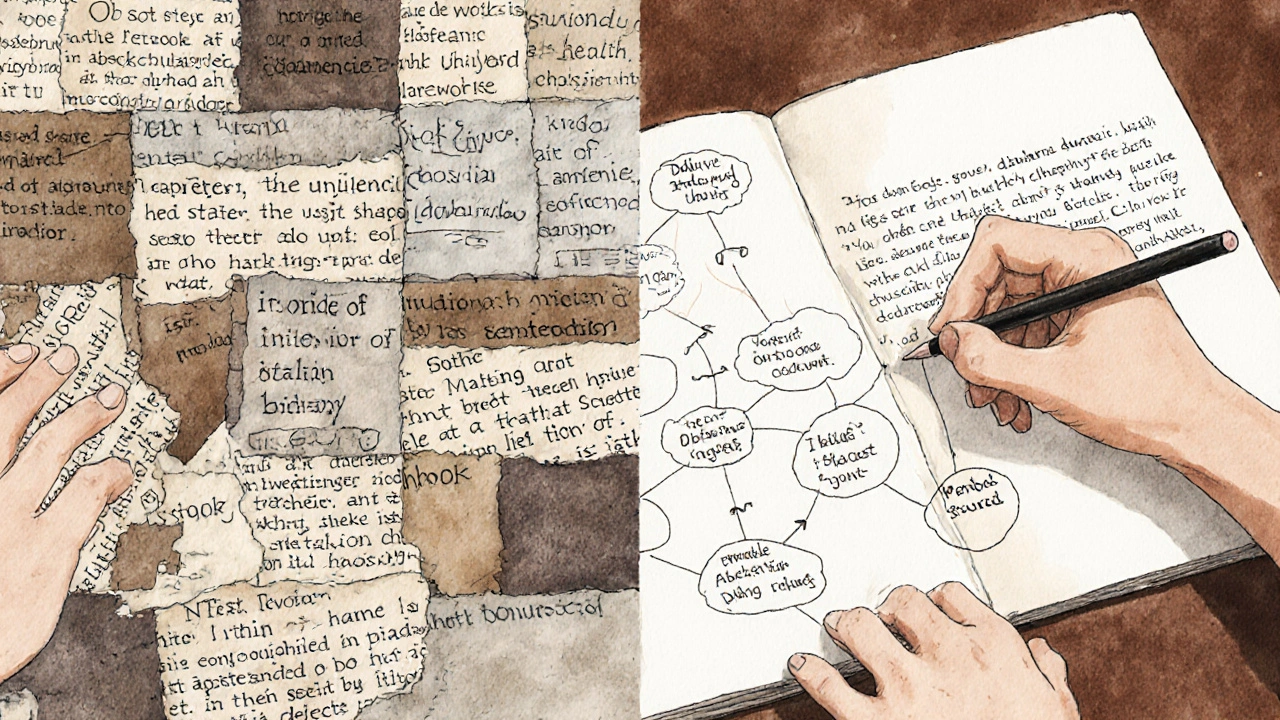
Every year, UK universities reject hundreds of student papers-not because the ideas are weak, but because the writing looks like a collage of copied sentences. This isn’t plagiarism in the old sense of copying whole paragraphs. It’s patchwork plagiarism: stitching together phrases from different sources, swapping out a few words, and hoping no one notices. It’s easy to do. It’s also easy to catch. And it’s one of the most common reasons students fail their assignments.
What Is Patchwork Plagiarism?
Patchwork plagiarism happens when you take small chunks of text from multiple sources, rearrange them, and call it your own. You might change ‘the government has implemented’ to ‘the state has introduced,’ keep the structure, and add a citation at the end. That’s not paraphrasing. That’s just dressing up someone else’s sentence in different clothes.
UK universities use Turnitin and other tools that don’t just look for exact matches. They flag patterns-similar sentence structures, unusual word combinations, and phrasing that doesn’t match your usual writing style. Even if you cite the source, if the language isn’t yours, it’s still academic misconduct.
Think of it like this: if you copied a friend’s essay word-for-word, you’d get in trouble. Patchwork plagiarism is the same thing-just with more effort and less honesty.
Why Students Fall Into This Trap
Most students don’t set out to cheat. They’re stressed, pressed for time, and unsure how to write academically. They read a few journal articles, highlight sentences that sound smart, and try to reuse them. They think, ‘If I change a few words and add a reference, it’s fine.’
But academic writing isn’t about sounding impressive. It’s about showing you understand the material well enough to explain it in your own voice. If you can’t rephrase a sentence without looking at the original, you don’t truly understand it yet.
Another problem? Many students confuse synthesis with patchwork. Synthesis means combining ideas from multiple sources to build your own argument. Patchwork means borrowing phrases to fill gaps in your thinking. One builds knowledge. The other hides a lack of it.
The Difference Between Paraphrasing and Patchwork
Good paraphrasing isn’t a word swap. It’s a complete rewrite from memory.
Here’s how to do it right:
- Read the original passage until you fully understand it.
- Close the source-no peeking.
- Explain the idea out loud, as if you’re telling a friend.
- Write down what you said, using your own words and sentence structure.
- Only then, check the original to make sure you didn’t accidentally copy a phrase.
- Add a citation to credit the source.
Compare this:
Original (Smith, 2023): ‘The rise of remote work has fundamentally altered workplace dynamics, particularly in how teams communicate and collaborate across time zones.’
Patchwork version: ‘Remote work has changed workplace dynamics, especially in team communication and collaboration across different time zones (Smith, 2023).’
Proper paraphrase: ‘When teams no longer share an office, the way they talk and work together shifts. Smith (2023) found that time zone differences now shape how often people check in and what tools they use to stay aligned.’
The second version isn’t just reworded-it’s rethought. It uses different structure, different emphasis, and sounds like you’re explaining it, not quoting it.

Synthesis: Building Your Own Argument
Synthesis is what professors actually want. It means reading multiple sources, spotting connections, and using them to support your own point.
For example:
- Smith (2023) says remote work improves work-life balance.
- Lee (2022) argues it reduces team cohesion.
- Chen (2024) found hybrid models work best when managers set clear expectations.
A synthesis paragraph might look like this:
While remote work offers flexibility that improves employee well-being (Smith, 2023), it also creates challenges in maintaining team unity (Lee, 2022). The most effective solutions aren’t fully remote or fully in-office-they’re hybrid, but only when managers actively structure communication. Chen’s (2024) research shows that clear guidelines on response times and meeting schedules reduce the isolation employees feel, turning flexibility into a strength rather than a liability.
Notice: No copied phrases. No stitched sentences. Just ideas merged into a new insight. That’s synthesis. That’s academic writing.
Tools That Help-And Tools That Hurt
There are AI tools that promise to ‘rewrite’ your text. Some students use them to ‘paraphrase’ their sources. But here’s the catch: these tools don’t understand context. They swap synonyms, shuffle clauses, and often produce awkward, unnatural sentences that scream ‘I used a generator.’
Turnitin now flags AI-generated paraphrasing. Universities in the UK have started training their systems to detect these patterns. If your writing suddenly sounds robotic, or if your tone shifts mid-paragraph, you’re at risk.
Use tools like Grammarly for grammar, not for rewriting. Use Zotero to manage sources. Use citation generators to format references. But never use a tool to rewrite someone else’s ideas into your paper.

How to Practice Real Paraphrasing
Start small. Pick one paragraph from a journal article. Don’t read it again after you’ve understood it. Write your version without looking. Then compare.
Ask yourself:
- Did I keep the same sentence structure? (If yes, rewrite it.)
- Did I use the same key phrases? (If yes, find synonyms or restructure.)
- Does this sound like something I’d say in a conversation? (If not, simplify it.)
Try this exercise: Take a paragraph from your reading and turn it into a tweet. You have 280 characters. Can you capture the core idea in your own words? If you can, you’ve paraphrased.
What Happens If You Get Caught?
UK universities take academic integrity seriously. A first offense might mean a zero on the assignment. A second could lead to suspension. In extreme cases, students lose their degree.
But the real cost isn’t just the grade. It’s your reputation. Professors remember students who rely on patchwork writing. They notice when your writing doesn’t improve over time. They notice when your voice disappears in your essays.
Academic writing isn’t about hiding your sources. It’s about showing your thinking.
Final Checklist: Are You Writing or Stitching?
Before you submit any paper, ask yourself:
- Did I read each source deeply enough to explain it without looking?
- Do all my paraphrased sections sound like me?
- Have I synthesized ideas from multiple sources into a new argument-or just copied phrases?
- Would my professor recognize this as my voice, or someone else’s?
If you answered ‘no’ to any of these, go back. Rewrite. Rebuild. It’s better to turn in a shorter, honest paper than a long, borrowed one.
Good academic writing doesn’t come from copying. It comes from thinking, rethinking, and rewriting until your ideas take shape. That’s the work. That’s the point.
Is paraphrasing allowed in UK academic writing?
Yes, paraphrasing is not only allowed-it’s expected. But it must be done properly: you must understand the original idea, rewrite it in your own words and structure, and still cite the source. Simply changing a few words or rearranging sentences without true understanding counts as patchwork plagiarism.
Can I use AI tools to paraphrase my sources?
Using AI to rewrite text is risky. Many tools generate surface-level changes that don’t reflect true understanding. UK universities are now training detection systems to spot AI-generated paraphrasing. Even if the text is cited, if it sounds robotic or unnatural, it can be flagged as academic misconduct. Use AI for editing grammar or organizing ideas, not for rewriting others’ content.
What’s the difference between synthesis and patchwork plagiarism?
Synthesis means combining ideas from multiple sources to form your own original argument. Patchwork plagiarism means borrowing phrases and stitching them together with minor changes. Synthesis shows critical thinking. Patchwork hides a lack of it. Synthesis has your voice. Patchwork has someone else’s.
Do I need to cite if I paraphrase?
Yes. Even if you rewrite everything in your own words, the idea still belongs to someone else. Failing to cite a paraphrased idea is plagiarism. Always credit the original author, whether you’re quoting directly or summarizing.
How do universities detect patchwork plagiarism?
Tools like Turnitin don’t just look for copied text. They analyze sentence structure, word choice patterns, and writing style. If your paper suddenly uses complex phrases you’ve never used before, or if multiple sentences match sources too closely in structure, the system flags it. Many UK universities also train markers to spot unnatural phrasing that doesn’t match a student’s usual writing.